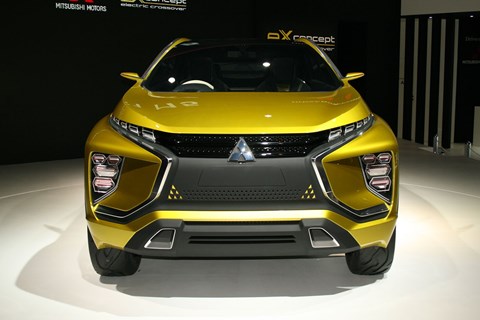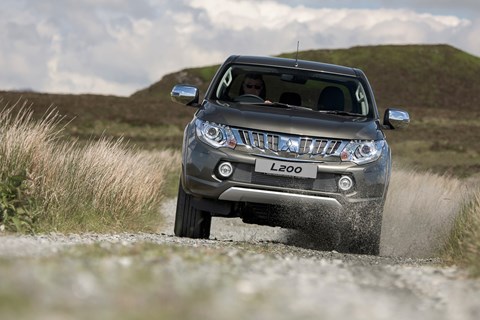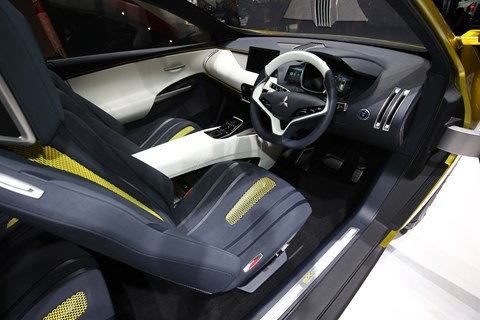► CAR interviews Mitsubishi design boss
► Tsunehiro Kunimoto on Mitsu’s future
► Five new SUVs on the way
It’s a rare event for personnel to switch between major car companies in Japan. Moving from one brand to another isn’t a regular event, especially for a senior figure with a successful 40-year career already under their belt. But Mitsubishi’s recently appointed design boss Tsunehiro Kunimoto isn’t afraid to break the occasional mould.
He joined Mitsu in 2014 from a four-decade stint at Nissan, where he held the position of global design manager. Among other projects his CV includes work on the 2001 Z Concept sports car, the big and bold Infiniti FX SUV, and the template-setting R32 Skyline. He also played a key role in the distinctive-looking, and big-selling, Nissan Juke – a project that’s particularly pertinent to Mitsubishi as the company looks to gain a foothold in the compact B-SUV market in the near future.
Now he’s tasked with creating a stronger design identity for Mitsubishi, and helping to rebrand the company as a specialist in SUVs and electric powertrains.
We sat down with Tsunehiro Kunimoto at the 2016 Geneva motor show to learn more about life after Nissan, and Mitsubishi’s future.
Mitsubishi’s new face, and new brand direction
‘Joining Mitsubishi [from Nissan] is fun, because of the two different company cultures. I’m enjoying the change,’ Kunimoto tells CAR.
‘Apart from starting a new design strategy, my role is also to help establish a new brand strategy,’ Kunimoto says. ‘I like to establish identity and character – I find that kind of strategy-making the most enjoyable. I established those things after 2000 with Nissan. I am very proud of that.’
And just as tapping into the crossover market gave Nissan sales a huge shot in the arm, SUVs loom large in Mitsubishi’s future strategy. The company plans to launch five new SUV models in Europe by 2021.
First new model out of the blocks will be a mid-sized SUV a little larger than the current ASX, and with styling similar to the XR-PHEV II concept first seen in 2013. That will be followed in 2018 by the replacement Outlander, and in 2019 by potentially the most exciting of the new line-up – a compact B-SUV to go toe to toe with the Nissan Juke, previewed by the eX concept displayed at this 2016’s Geneva show (pictured below).
Click here to read more about Mitsubishi’s future product plans.

‘Our customers are very much grounded in the Mitsubishi family. Of course we need to make a big jump in some products, but I want to keep the values. So the new front face design is also bound up in our history.’
That new face is nicknamed ‘dynamic shield’, mixing an aggressive-looking X-shaped black area (the ‘dynamic’ bit) with outer square-cut tab-shaped sections (the ‘shield’ bit).
‘[Traditionally], performance expression comes from [the shape of the] air intakes. But air intakes do not need to be big any more. So in this century, the grille area has a black finish to make it a performance-expressing ID device.’ But there is a practical function too: ‘We can put many devices inside the black area. Long-distance scanning radar, cameras [for adaptive cruise control and semi-autonomous driving systems]. The black colour is very positive for radar function. It makes the engineers very happy! Metal is difficult but black [surfaces] have no negative impact to radar. So it’s an interesting opportunity: performance expression by air intake, but now with a different function.’
What is Mitsubishi’s design identity? What makes a Mitsubishi a Mitsubishi?
In the UK, some might associate Mitsubishi with rally-rocket Evos, others with hill farm-spec L200 pickups (pictured below). Does the brand need a more cohesive identity?
‘After I joined, I wanted to know: “What is a Mitsubishi?”,’ Kunimoto admits. ‘I visited strong Mitsubishi market areas in the east and in parts of Europe and Russia, and interviewed customers. And the communication was very interesting. For example, I visited Thailand, where a lot of people use Mitsubishi trucks. The owner uses it for business on the weekday, and the weekend with his family on very rough roads so people appreciate the Mitsubishi products because they’re very tough, very strong. And some people have been driving the same truck for 20 years without much trouble. They are easy to maintain and the body and chassis is very tough. So in Thailand and Indonesia many people said that is the Mitsubishi product advantage. I also had interviews in Germany, and England, and despite more low-key use people say the same thing: strong, reliable. And an honest image.’

‘So, I selected ‘form follows function’ as a key quality. Many automobile companies say, “okay, the emotional value is more important than the functional value, and also the emotional value is a part of the functional value.” Yes it is, but our case is more pure usage, so that is a key part of our design philosophy. You need toughness, and a reliable image, also.’
‘Of course, today we showed the eX concept, a very compact car. [In that segment] many customers come from hatchbacks, sedans, and the ratio of female buyers is higher than other categories in general. So those customers’ expectations are totally different – but I want to show the same philosophy. Different from our competitors – our design direction is not the same as Kia, Hyundai. I want to be differentiated.’
What about electric cars?
Both pure electric and hybrid powertrains are a priority for Mitsubishi’s developers currently, but Kunimoto says they will be offered as model variants, not as separate standalone models.
‘Our direction is not to develop just one EV product, like [BMW’s] i3 or i8. Our direction is we will have three main pillars of the SUV [models] from now on – the new Outlander, the new mid-sized SUV and today we have shown a small compact SUV. All of those three models will have a PHEV [variant]. The current Outlander has a petrol, diesel and PHEV, so the next one the same.’

A ‘strong quest’ to improve interior quality
Mitsubishi interiors for some years have been locked in a battle between utilitarian toughness and durability versus the need for a more upmarket feel. Until recently, hard plastics have traditionally ruled OK over soft-touch finishes.
That’s something that’s about to change, with the eX concept’s more European-style interior (pictured above) a portent of things to come.
‘Currently we have a strong quest to improve the Outlander’s interior. We need [better] perceived quality, better finishing to provide more [a] more high quality [environment] to the customer – especially with the PHEV. The next Outlander will have very different interior quality and finishing.’
New European design centre
One of Kunimoto’s first moves on joining Mitsubishi was to re-open the company’s European design studio near Frankfurt, which had previously lain dormant for several years. The team of designers in Germany work in close contact with the principle design studio in Japan, with regular video links between the two centres.
‘After I joined, I immediately opened the studio so we could find many strong designers [in Europe], because they bring a very interesting [viewpoint],’ Kunimoto told CAR. ‘Of course, the final design is modified by Japan, but it’s a collaboration. The [initial] designs start in Europe.’
We’ll get our first look at the fruits of Kunimoto’s labours at the Geneva show this time next year. ‘At Geneva 2017 we will introduce a new product range, and also begin to introduce the new brand identity. I am very busy at the moment,’ he smiles.